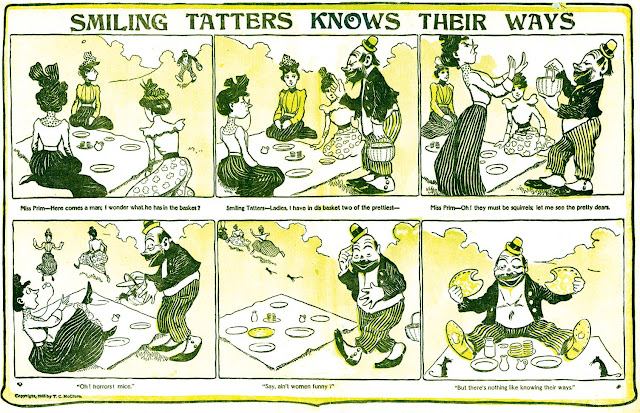If you have my book, today's one of those days when you need to crack it open and do some surgery. It turns out that listing #5768, Smiling Tatters, needs to be stricken.
Why, you wonder? Well, this situation is another illustration of how even when you have the material right in front of you, errors can happen. I indexed the early McClure Syndicate sections based on the New York Press. I went through the paper on microfilm, which can be tough because Sunday comics are usually dark and muddy, making signatures (when they exist) hard or even impossible to read, and art-spotting prone to error for the same reason.
Compounding those problems is that back in those early days of newspaper comics there were lots of one-shots, which can muddy the waters as the researcher writes tons of notes just in case it turns out that what seems like a one-shot turns into a series. You record character names for all those one-shots just on the off-chance that the artist will decide to return to that character after all.
When you think you have a series, you still have the challenge that installments of it might pop up weeks or even months apart. Series strips in those days were rarely identifiable by a standard continuing title, but just by the recurrent characters therein. In other words, imagine the every time you open your current Sunday comics that Mutts isn't titled Mutts -- it varies every Sunday, with titles perhaps like "Mooch and Crabby Agree on One Thing," and "Summer Can't Get Here Too Soon for Earl", and so on. In order to identify the series, you look at art style and characters.
So, with all those excuses out of the way, here's an example of a situation in which I screwed up. On July 13 1902 I saw this strip, keeping in mind that I was seeing it on microfilm, not a scan from a tearsheet like this:
It was unsigned, and way back when I did this indexing I was somewhat less sure of myself at IDing art styles. I'm still not nearly as good as I'd like to be, but I now say with pretty good confidence that this is most likely the work of Ed Carey. Anyway, when I saw this on microfilm I saw a plausible beginning of a series starring a beggar names Smiling Tatters, and wrote it in my indexing notes.
Several reels of microfilm later, in the August 31 1902 New York Press I encountered this strip:
Not having a photographic memory I see this strip, note that I already had an index entry for Smiling Tatters, and think, hey, I've got a bona fide series! And bonus, this episode is initialed by Mark Fenderson, so now I know the creator. If I was looking at the two strips in good shape, in colour, and right next to each other like this, I would have seen the obvious -- the characters are not designed the same (beyond being standard hobo types), and the art style is different, too. But short of engaging a second microfilm viewer, reloading the reel that had the other strip, and comparing them side by side, I was on my way down the yellow brick road.
An aside -- character names for certain types were used over and over, making this sort of error all too easy. Half the kids in comics in those days were named Willie, the cops were mostly Clancys, and hoboes, who were exceedingly popular subjects, were very often Tatters or Waggles. But they threw me a real curveball on this one, adding the adjective 'Smiling' to really seal the deal on me makng an error.
Now that I thought I had a series, I compunded my error by finding another 'Tatters' strip many reels later, on November 23 1902 (sorry, this one I can only show from digitized microfilm):
Here I really went off the rails, thinking apparently that, well, 'Fatty', 'Smiling', whatever, probably the same hobo, since he has the same name, right? And he does seem to be a happy, smiling fellow to boot. Getting stuck on requiring perfect consistency from these early cartoonists can land you in just as much hot water as the opposite can. Also, on the microfilm I was indexing those initials in the last panel could very well have been much more obscure and led me to assume they were Fenderson's again. With this version I can see pretty clearly that who we really have here is A.D. Reed, yet another McClure artist! I do have trouble distinguishing between Reed and Fenderson, whose styles are not so distinctively different to me. So what a relief that they both signed their respective strips since they were notorious for not bothering to take credit on their work.
Anyway, all those mea culpas out of the way, take the trusty old marker out and make a great big 'X' through listing #5768!



Hello Allan-
ReplyDeleteAllow me to play Beelzebub's Perry Mason; Could this not still be considered a series, as they are of the same syndicate? Some titles are started by one artist and carried on by another. Even though this lasted only two, or maybe 2½ times, is'nt that technically a series?
Okay, Satan's consigliere, if I consider anything from a syndicate with the same character name to be a series then we're in hip-deep guano. By that token, any Hearst comic strip with a kid named Jimmy is now fused at the hip joint with Mr. Swinnerton's magnum opus?
ReplyDeleteYour point is well taken, though. If those two and a half hoboes shared more than a happy expression on their faces -- something that signalled that they were supposed to be a running character and not just named as the product of cartoonist laziness, I'd be on board.
--Allan